Beijing-Shanghai High-Speed Railway Bundle
How has the Beijing-Shanghai High-Speed Railway transformed China?
Journey with us through the remarkable story of the Beijing-Shanghai High-Speed Railway, a project that redefined modern infrastructure. From its inception in the late 1980s to its current status as a global leader, this railway company has reshaped travel between China's economic powerhouses. Discover the engineering marvels, financial successes, and strategic innovations that propelled the Beijing-Shanghai High-Speed Railway SWOT Analysis to become a symbol of China's progress.
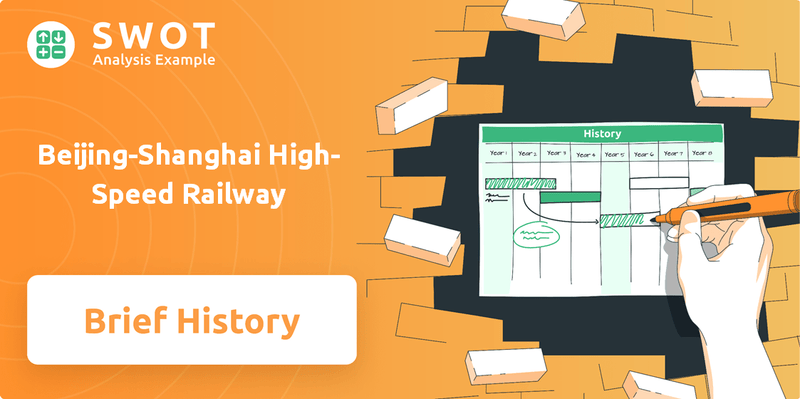
The Beijing-Shanghai High-Speed Railway stands as a testament to China's ambition and technological prowess. This Railway Company not only connects Beijing and Shanghai, but also symbolizes the nation's commitment to efficient and modern transportation. Understanding the High-Speed Rail History of this line provides crucial insights into China's economic and infrastructural advancements, including its impact on the China Railway network and the evolution of CRH Trains.
What is the Beijing-Shanghai High-Speed Railway Founding Story?
The founding of the Beijing-Shanghai High-Speed Railway Company marks a significant chapter in the history of high-speed rail in China. Officially established on January 9, 2008, the company's creation was the culmination of years of planning and strategic vision to address the growing transportation needs between Beijing and Shanghai. The project aimed to revolutionize travel between these two major cities.
The conceptualization of the Beijing-Shanghai High-Speed Railway, also known as the Beijing Shanghai Railway, began much earlier. The Ministry of Railways (MOR) proposed its construction to the State Council in 1990, recognizing the limitations of existing conventional rail lines. The primary goal was to alleviate bottlenecks and inefficiencies in passenger and freight transport, paving the way for a dedicated high-speed passenger line. This initiative was crucial for regional economic integration.
The establishment of the Beijing-Shanghai High-Speed Railway Company was a strategic move by the Chinese government, with the Ministry of Railways taking a leading role. The company was set up as a state-owned entity, responsible for raising funds and overseeing the project's execution. The initial business model focused on providing high-speed rail passenger services, generating revenue primarily through ticket sales. The company's financial strategy involved a mix of funding sources, including its own fundraising efforts, contributions from local governments, share offerings, bank loans, and even foreign investment, setting a precedent for railway projects in China. You can learn more about the Target Market of Beijing-Shanghai High-Speed Railway.
The Beijing-Shanghai High-Speed Railway Company's establishment involved significant challenges and strategic decisions. The project's massive scale and complexity demanded careful planning and execution. The line's construction included extensive infrastructure, such as numerous bridges, including the world's longest Danyang-Kunshan Grand Bridge. Early debates over technology choices and financial oversight were also critical aspects of the company's initial phase.
- The initial investment was estimated at ¥220 billion (approximately $32 billion) by July 2008.
- The total investment in the project ultimately reached ¥217.6 billion (approximately $34.7 billion).
- The line covers a distance of 1,318 kilometers, with 87% of it elevated.
- The railway includes 244 bridges.
Beijing-Shanghai High-Speed Railway SWOT Analysis
- Complete SWOT Breakdown
- Fully Customizable
- Editable in Excel & Word
- Professional Formatting
- Investor-Ready Format
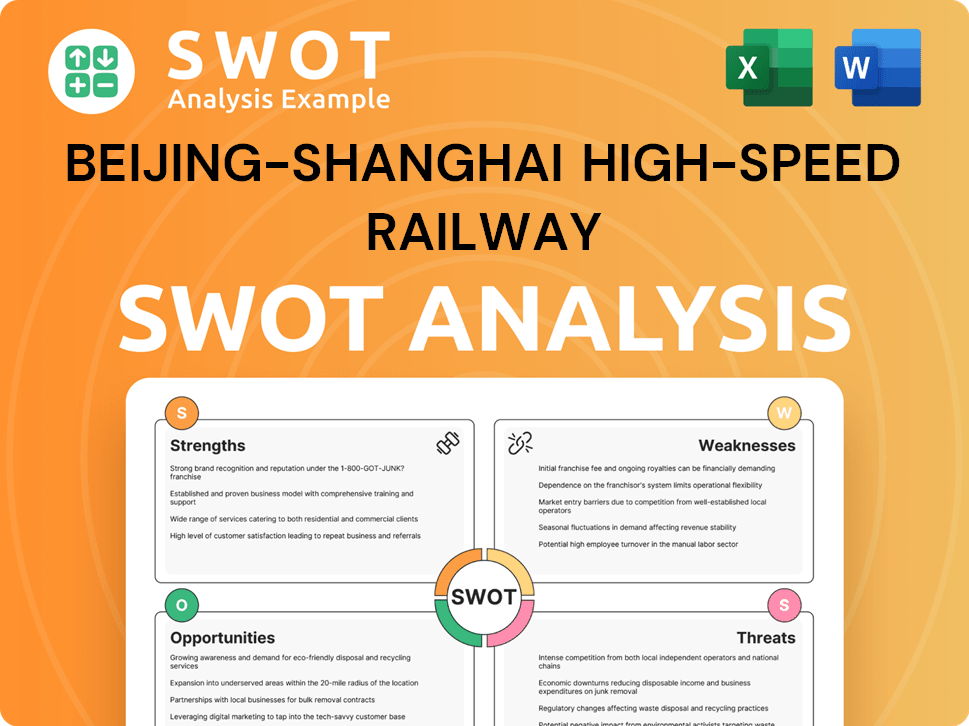
What Drove the Early Growth of Beijing-Shanghai High-Speed Railway?
The early years of the Beijing-Shanghai High-Speed Railway Company were marked by significant growth and strategic developments. Construction began on April 18, 2008, and the railway officially launched on June 30, 2011. Initially operating at 300 km/h, the railway quickly became a crucial transportation link between major cities. The history of Beijing-Shanghai high-speed railway construction showcases the project's ambition.
The Beijing-Shanghai High-Speed Railway, designed for 350 km/h, initially ran at 300 km/h for safety. This High-Speed Rail History includes the railway's early operational challenges and successes. Key cities like Jinan, Bengbu, Xuzhou, and Nanjing benefited from the railway's connectivity. The railway's impact on the economy was immediately evident.
The Beijing-Shanghai High-Speed Railway Company demonstrated strong financial performance early on. By the end of 2015, the company reported a net profit of RMB 6.5 billion (approximately $1 billion). The company announced a net profit of ¥9.5 billion (US$1.35 billion) in the first nine months of 2019. This financial success highlighted the demand for the Beijing-Shanghai High-Speed Railway.
On January 16, 2020, the Beijing-Shanghai High-Speed Railway Company went public, becoming the first high-speed rail operator in China to do so. The IPO raised 30.67 billion yuan (approximately $4.74 billion). The funds were used to acquire a 65% stake in the Beijing Fuzhou Railway Passenger Dedicated Line Anhui Company. For more details, check out Revenue Streams & Business Model of Beijing-Shanghai High-Speed Railway.
The Beijing-Shanghai High-Speed Railway has consistently attracted high passenger numbers. In 2024, over 52 million passengers traveled between Beijing and Shanghai by train. This number significantly surpassed the 8.6 million who traveled by air on the same route. Passenger preference for CRH Trains has been a key factor.
Beijing-Shanghai High-Speed Railway PESTLE Analysis
- Covers All 6 PESTLE Categories
- No Research Needed – Save Hours of Work
- Built by Experts, Trusted by Consultants
- Instant Download, Ready to Use
- 100% Editable, Fully Customizable
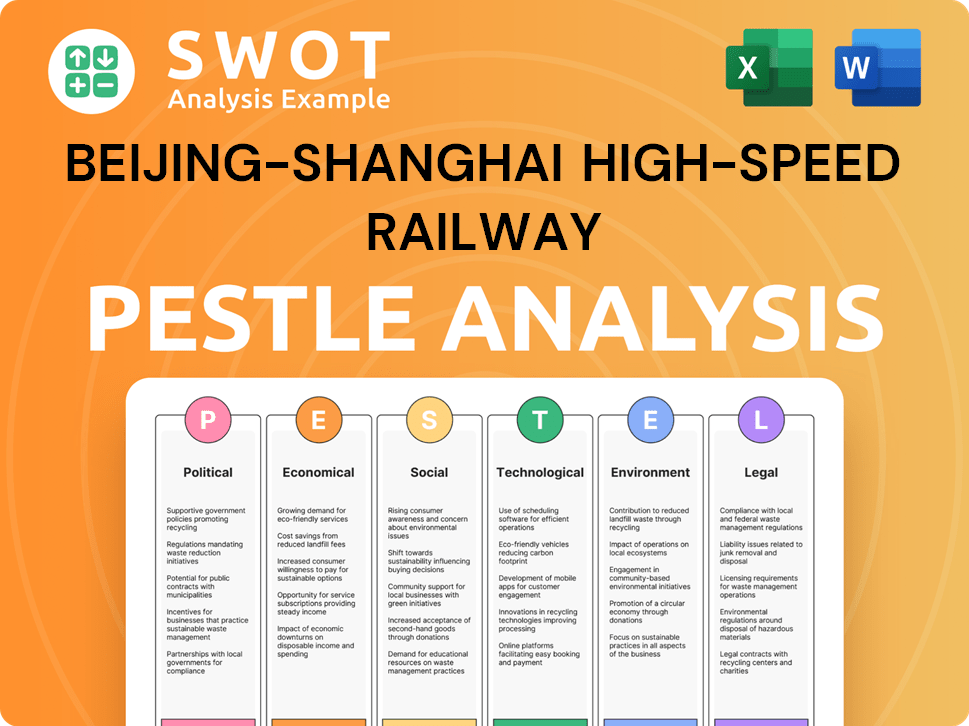
What are the key Milestones in Beijing-Shanghai High-Speed Railway history?
The Beijing-Shanghai High-Speed Railway has marked several significant milestones since its inception, transforming the landscape of high-speed rail travel in China. The project's development and operational history reflect its ambition and impact on the nation's infrastructure and economy.
| Year | Milestone |
|---|---|
| April 18, 2008 | Construction of the Beijing-Shanghai High-Speed Railway officially commenced, marking the beginning of a large-scale infrastructure project. |
| 2010 | The CRH380A high-speed train achieved a world record operational speed of 486.1 km/h, showcasing advanced rail technology. |
| June 30, 2011 | The Beijing-Shanghai High-Speed Railway officially opened, significantly reducing travel time between the two major cities to under five hours. |
| January 2020 | The Beijing-Shanghai High-Speed Railway Company's IPO was launched as part of China Railway's strategy to monetize assets and address debt. |
The railway's development has been characterized by numerous innovations, especially in high-speed rail technology. A key advancement was the establishment of China's standard for 350km/h high-speed rail, which involved breakthroughs in infrastructure construction.
The project included the construction of the Danyang–Kunshan Grand Bridge, the world's longest bridge at 164 km, and advanced ballastless track technology. These innovations were crucial for ensuring the railway's operational efficiency and safety, especially in complex environments.
The development of the new generation high-speed EMUs, such as the CRH380A, capable of running at 350km/h, was a major technological achievement. These trains not only improved speed but also enhanced passenger comfort and safety.
The railway played a key role in establishing China's standards for high-speed rail technology. This standardization facilitated the expansion of high-speed rail across the country, improving interoperability and efficiency.
The innovations led to numerous patents for inventions, applications, and designs. This intellectual property underscored China's growing technological prowess in the rail sector and its commitment to indigenous innovation.
The railway's operational efficiency was enhanced through advanced signaling systems and maintenance practices. These improvements helped maintain high levels of punctuality and reliability.
The implementation of advanced safety features, including sophisticated braking systems and monitoring technologies, was a priority. These systems were designed to prevent accidents and ensure passenger safety.
Despite its successes, the Beijing-Shanghai High-Speed Railway has faced significant challenges, including operational issues and management concerns. Early operational problems, such as power failures and train stoppages, led to public scrutiny and safety concerns.
Early operational issues, such as power failures and train stoppages, led to passenger inconvenience and public scrutiny. These disruptions highlighted the need for improved reliability and maintenance protocols.
In August 2011, a recall of 54 bullet trains due to flaws in their automatic braking systems raised safety concerns. This incident prompted a temporary reduction in operational speed and increased scrutiny of safety measures.
Audit reports revealed issues of fraud, waste, mismanagement, and irregular procurement during the construction phase, totaling billions of yuan. These issues included faulty bidding procedures and inflated material costs.
The IPO in January 2020 was part of a broader plan by China Railway to overhaul its structure, monetize assets, and address debt. This move aimed to improve financial sustainability and operational efficiency.
In response to these challenges, the railway sector implemented enhanced safety measures and improved management practices. This included more rigorous testing, maintenance, and operational protocols.
Lessons learned from these experiences have contributed to the development of a more robust and standardized high-speed rail system. This emphasis on indigenous innovation and continuous improvement has been central to the railway's success.
Beijing-Shanghai High-Speed Railway Business Model Canvas
- Complete 9-Block Business Model Canvas
- Effortlessly Communicate Your Business Strategy
- Investor-Ready BMC Format
- 100% Editable and Customizable
- Clear and Structured Layout
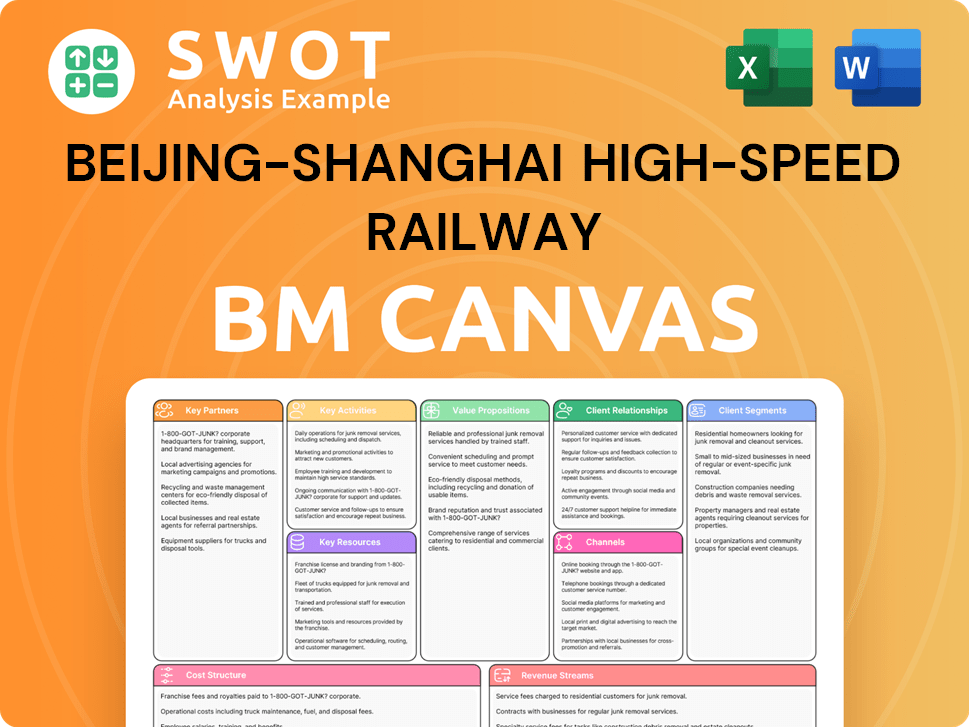
What is the Timeline of Key Events for Beijing-Shanghai High-Speed Railway?
The Beijing-Shanghai High-Speed Railway has a rich history, marked by significant milestones. The Ministry of Railways first considered the high-speed rail line in the late 1980s, with a formal proposal in 1990. The company itself was founded on December 27, 2007, and officially commenced operations on January 9, 2008. Construction began in April 2008, and the railway started operating on June 30, 2011. The company achieved profitability by 2014 and went public on January 16, 2020. The Beijing-Shanghai High-Speed Railway's journey reflects China's commitment to advanced transportation infrastructure.
| Year | Key Event |
|---|---|
| Late 1980s | Ministry of Railways begins considering a high-speed rail line between Beijing and Shanghai. |
| 1990 | Ministry of Railways proposes the construction of the Beijing-Shanghai high-speed rail to the State Council. |
| December 27, 2007 | Beijing-Shanghai High-Speed Railway Co., Ltd. is founded. |
| January 9, 2008 | Official founding date of Beijing-Shanghai High Speed Railway Co.,Ltd. |
| April 18, 2008 | Construction of the Beijing-Shanghai High-Speed Railway officially commences. |
| December 3, 2010 | CRH380A train reaches an operational speed of 486.1 km/h on the Beijing-Shanghai High-Speed Railway, setting a world record. |
| June 30, 2011 | Beijing-Shanghai High-Speed Railway officially begins operation. |
| August 2011 | 54 bullet trains on the Beijing-Shanghai line recalled due to safety concerns related to braking systems. |
| 2014 | The company begins to report sustained profitability. |
| End of 2015 | Reports a net profit of RMB 6.5 billion (approximately $1 billion). |
| First nine months of 2019 | Reports a net profit of ¥9.5 billion (US$1.35 billion). |
| January 16, 2020 | Beijing-Shanghai High-Speed Railway Co., Ltd. goes public on the Shanghai Stock Exchange, raising 30.67 billion yuan (approximately $4.74 billion). |
| 2024 | Generates approximately $5.9 billion in revenue and $1.79 billion in net profit. |
| April 2025 | Beijing-Shanghai High-Speed Railway and China Railway Economic Planning and Research Institute sign a strategic cooperation framework agreement for in-depth cooperation in operation management, maintenance standard formulation, and digital construction. |
The future of the Beijing-Shanghai High-Speed Railway looks promising. The high-speed rail network in China is projected to expand significantly. The total length of operating high-speed rail tracks is expected to reach 60,000 km by 2030, up from 48,000 km at the end of 2024.
The company is focused on optimizing its operations. It is also considering mergers and acquisitions within the railway industry to enhance connectivity. This strategic approach aligns with its goals of offering efficient, fast, and comfortable passenger transport.
High-speed rail continues to dominate intercity travel due to its punctuality, comfort, and city-center access. The Beijing-Shanghai line is expected to remain a financial success. Strong revenue streams will enable continued investment in technology and service improvements.
In 2024, the company generated approximately $5.9 billion in revenue and $1.79 billion in net profit. The line's financial health supports reinvestment and enhancements. The railway's success is a cornerstone of China's transportation infrastructure.
Beijing-Shanghai High-Speed Railway Porter's Five Forces Analysis
- Covers All 5 Competitive Forces in Detail
- Structured for Consultants, Students, and Founders
- 100% Editable in Microsoft Word & Excel
- Instant Digital Download – Use Immediately
- Compatible with Mac & PC – Fully Unlocked
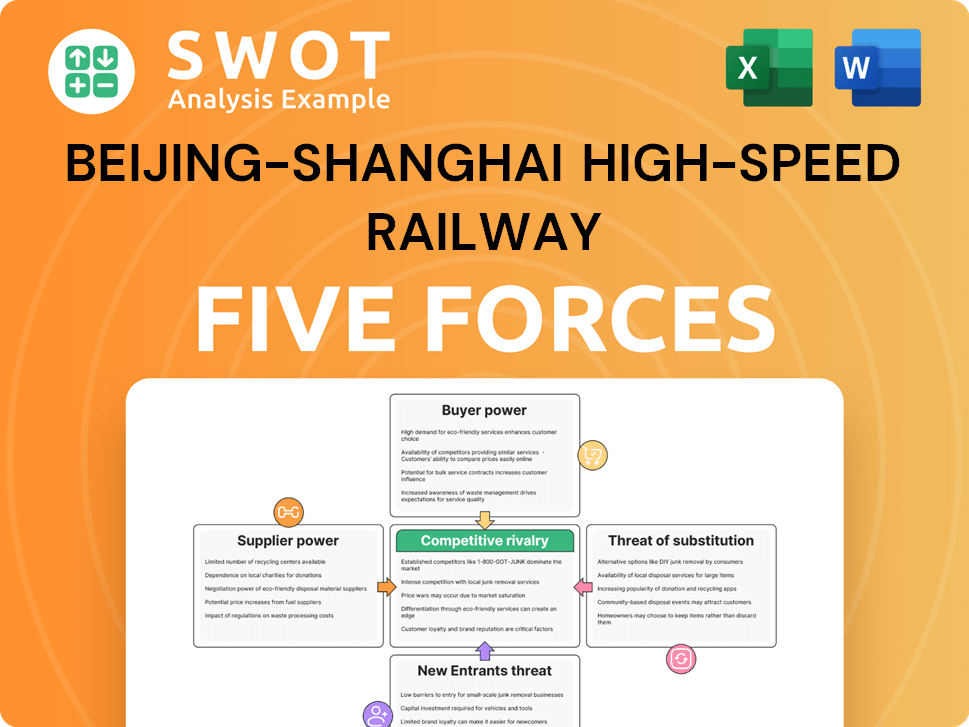
Related Blogs
- What is Competitive Landscape of Beijing-Shanghai High-Speed Railway Company?
- What is Growth Strategy and Future Prospects of Beijing-Shanghai High-Speed Railway Company?
- How Does Beijing-Shanghai High-Speed Railway Company Work?
- What is Sales and Marketing Strategy of Beijing-Shanghai High-Speed Railway Company?
- What is Brief History of Beijing-Shanghai High-Speed Railway Company?
- Who Owns Beijing-Shanghai High-Speed Railway Company?
- What is Customer Demographics and Target Market of Beijing-Shanghai High-Speed Railway Company?
Disclaimer
All information, articles, and product details provided on this website are for general informational and educational purposes only. We do not claim any ownership over, nor do we intend to infringe upon, any trademarks, copyrights, logos, brand names, or other intellectual property mentioned or depicted on this site. Such intellectual property remains the property of its respective owners, and any references here are made solely for identification or informational purposes, without implying any affiliation, endorsement, or partnership.
We make no representations or warranties, express or implied, regarding the accuracy, completeness, or suitability of any content or products presented. Nothing on this website should be construed as legal, tax, investment, financial, medical, or other professional advice. In addition, no part of this site—including articles or product references—constitutes a solicitation, recommendation, endorsement, advertisement, or offer to buy or sell any securities, franchises, or other financial instruments, particularly in jurisdictions where such activity would be unlawful.
All content is of a general nature and may not address the specific circumstances of any individual or entity. It is not a substitute for professional advice or services. Any actions you take based on the information provided here are strictly at your own risk. You accept full responsibility for any decisions or outcomes arising from your use of this website and agree to release us from any liability in connection with your use of, or reliance upon, the content or products found herein.